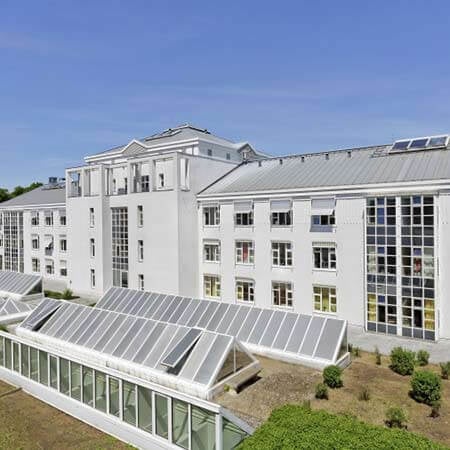Top Hospitals for Treatment of Lumbar Spinal Stenosis in Germany
Each hospital in this list meets Booking Health’s strict international standards: at least 250 surgeries per year, ISO‑certified quality management, and documented survival outcomes. Our medical board then ranks the clinics by clinical expertise, technology, and patient‑satisfaction scores.

The Hospital Neuwerk, which is in Moenchengladbach, has over 10 specialized operating departments. Located in the northern part of the city, the hospital has been a coordination center for the region for many years. The hospital has 310 comfortable beds for ist patients. Due to a wide range of medical services, the hospital offe

Diagnostic tests for lumbar spinal stenosis
Price from:
0.00
Go to the program Treatment of lumbar spinal stenosis (1 segment) with decompressive laminectomy and discotomy
Price from:
Go to the program
11318.51
10318.51 Treatment of lumbar spinal stenosis (2-3 segments) with decompressive laminectomy and discotomy
Price from:
Go to the program
15005.69
13505.69 Treatment of lumbar spinal stenosis (4 segments) with decompressive laminectomy
Price from:
Go to the program
16172.88
14672.88 Surgical treatment of lumbar spinal stenosis in combination with instability with decompressive laminectomy and the stabilizing operation (4 segment)
Price from:
Go to the program
28320.93
26020.93 Treatment of lumbar spinal stenosis in combination with instability with decompressive laminectomy and the stabilizing operation (1 segment)
Price from:
Go to the program
22959.92
20959.92 Treatment of lumbar spinal stenosis in combination with instability with decompressive laminectomy and the stabilizing operation (2-3 segments)
Price from:
Go to the program
28437.86
26137.86 Treatment of lumbar spinal stenosis (1 segment) with decompressive laminectomy
Price from:
Go to the program
11908.37
10908.37 Treatment of lumbar spinal stenosis (4 segments) with decompressive laminectomy and discotomy
Price from:
Go to the program
16210.47
14710.47 
The Vivantes Auguste-Victoria Hospital, has special expertise and received international recognition in the field of Urology, especially in the treatment of prostate cancer and also Oncology, Neurology, Cardiology and other directions. The possibilities of urological treatment include robot-assisted surgeries using the Da Vinci
Diagnostic tests for lumbar spinal stenosis
Price from:
0.00
Go to the program Treatment of lumbar spinal stenosis (1 segment) with decompressive laminectomy and discotomy
Price from:
12351.18
Go to the program Treatment of lumbar spinal stenosis (2-3 segments) with decompressive laminectomy and discotomy
Price from:
16612.64
Go to the program Treatment of lumbar spinal stenosis (4 segments) with decompressive laminectomy
Price from:
17950
Go to the program Surgical treatment of lumbar spinal stenosis in combination with instability with decompressive laminectomy and the stabilizing operation (4 segment)
Price from:
31750.4
Go to the program Treatment of lumbar spinal stenosis in combination with instability with decompressive laminectomy and the stabilizing operation (1 segment)
Price from:
25169.33
Go to the program Treatment of lumbar spinal stenosis in combination with instability with decompressive laminectomy and the stabilizing operation (2-3 segments)
Price from:
31869.42
Go to the program Treatment of lumbar spinal stenosis (1 segment) with decompressive laminectomy
Price from:
13081.98
Go to the program Treatment of lumbar spinal stenosis (4 segments) with decompressive laminectomy and discotomy
Price from:
17656.64
Go to the program 
The Catholic Clinic Koblenz-Montabaur is a modern medical facility with an excellent reputation in Germany and abroad. The medical center is an academic clinic of the University Hospital Mainz, which gives patients the opportunity to take advantage of scientific advances and innovative treatments. The clinic has the widest possi



Diagnostic tests for lumbar spinal stenosis
Price from:
0.00
Go to the program Treatment of lumbar spinal stenosis (1 segment) with decompressive laminectomy and discotomy
Price from:
11546.26
Go to the program Treatment of lumbar spinal stenosis (2-3 segments) with decompressive laminectomy and discotomy
Price from:
15522.7
Go to the program Treatment of lumbar spinal stenosis (4 segments) with decompressive laminectomy
Price from:
17117.93
Go to the program Surgical treatment of lumbar spinal stenosis in combination with instability with decompressive laminectomy and the stabilizing operation (4 segment)
Price from:
30282.54
Go to the program Treatment of lumbar spinal stenosis in combination with instability with decompressive laminectomy and the stabilizing operation (1 segment)
Price from:
24101.32
Go to the program Treatment of lumbar spinal stenosis in combination with instability with decompressive laminectomy and the stabilizing operation (2-3 segments)
Price from:
30135.34
Go to the program Treatment of lumbar spinal stenosis (1 segment) with decompressive laminectomy
Price from:
12624.71
Go to the program Treatment of lumbar spinal stenosis (4 segments) with decompressive laminectomy and discotomy
Price from:
16843.36
Go to the program 

